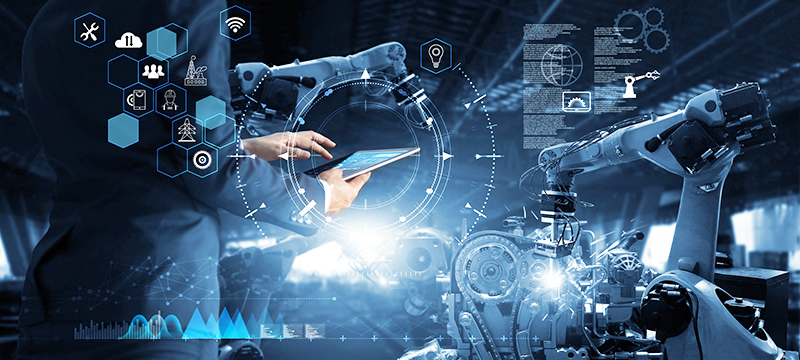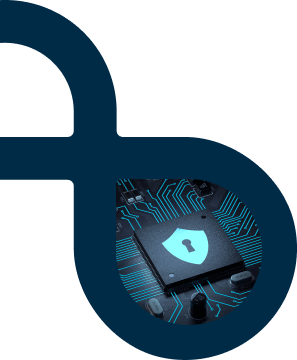Industry 4.0 The Digital Revolution
Often called the Fourth Industrial Revolution, Industry 4.0 revolves around the digital transformation of manufacturing and industrial processes. Its main goal is to create “Smart Factories” by integrating digital technologies into production. Its core focus is automation and efficiency through connectivity, such as real-time tracking of manufacturing errors.
- Technologies Include:
- Industrial Internet of Things (IIoT): Devices and machines interconnected to exchange data in real time.
- Cyber-Physical Systems (CPS): Integration of computational algorithms with physical processes.
- Big Data & Analytics: Real-time data collection and analysis for decision-making and predictive maintenance.
- Cloud Computing, AI/Machine Learning & Robotics.
- Production Model: Shifts from mass production to mass customization, though the primary aim remains high-efficiency and output.
- Role of Humans: Human workers primarily monitor and maintain automated systems, with the aim of minimizing manual intervention.
Industry 4.5 The Transitional Concept
Industry 4.5 is not a formally defined industrial revolution, but a helpful term used in describing the advanced stage of Industry 4.0, or a transition phase, moving towards deeper data integration and AI adoption.
The 4.5 concept dwells on cybersecurity and greater use of technologies like ‘Digital Twins’ (virtual replication of a physical object, process or system that uses real-time sensor data to mirror its real-world part’s behavior). This allows for 24/7 monitoring, predictive analysis and process simulation (without halting production).
4.5 is best understood as a practical, highly optimized execution of all Industry 4.0 technological pillars.
- Core Focus: Full maturity and sophisticated application of Industry 4.0 technologies.
- Key Emphasis: Advanced data analytics, digital twin technology and robust cybersecurity protocols.
Industry 5.0: The Human-Centric Revolution
Industry 5.0 builds upon the technological foundation of Industry 4.0, but shifts the focus beyond productivity and efficiency to prioritize three main values: Human-centricity, Sustainability and Resilience.
- Core Focus: Collaboration between humans and intelligent machines (co-working), placing people and planetary well-being at the center of production.
- Key Pillars/Values:
- Human-Centricity: Technology serving humans, enhancing their creativity, skills and quality of work, rather than replacing them, as in Collaborative Robots (Cobots).
- Sustainability: Focusing on resource efficiency, reducing waste, transitioning to renewable energy and enabling a Circular Economy.
- Resilience: Building robust and adaptive supply chains and production processes that can quickly respond to global disruptions (like pandemics or geopolitical events).
- Role of Humans: People work alongside technology, using it as an enhancement tool to leverage their own unique skills (creativity, critical thinking, emotional intelligence).
High-Performance PCBs Enabling Industrial Revolutions
Robotics & Motion Control: Robotic systems, from articulated arms to Automated Guided Vehicles (AGVs), all require high-performance PCBs for precise control and real-time processing.
- Motor Control & Power Management: PCBs in servo drives and motor controllers must handle significant current and heat while maintaining precise control signals. This requires heavy copper PCBs and specialized power plane designs to manage thermal loads and power distribution efficiently.
- Sensor Fusion & Feedback: Robotics rely on a complex network of sensors (vision, force, proximity). PCBs hosting the sensor interfaces and processing units must feature high-frequency materials and controlled impedance traces to ensure the integrity of the high-speed data being transmitted from the sensors back to the central controller.
- Miniaturization & Interconnection: Advanced robots, especially collaborative ‘Cobots’, require compact, light-weight electronics. This drives the need for High-Density Interconnect (HDI) PCBs and flexible/rigid-flex PCBs that can bend and conform to the robot’s mechanical structure while maintaining reliability.
Smart Factory & IIoT Infrastructure: The Smart Factory concept, supported by the Industrial Internet of Things (IIoT), connects machines, sensors and data centers. But it’s PCB technology that enables the devices for this interconnectivity.
- Real-Time Data Processing: Edge computing devices within the factory floor perform critical analysis on machine data. These PCBs require high layer counts and advanced routing techniques to support powerful processors and memory operating at high speeds, ensuring low-latency communication and rapid decision-making.
- Wireless Communication Modules: For true factory flexibility, countless devices communicate wirelessly (5G, Wi-Fi 6/7, etc.). PCBs in these IIoT gateways and sensors demand expertise in Radio Frequency (RF) design, including carefully tuned antenna layouts and the use of low-loss dielectric materials to minimize signal attenuation.
- Reliability & Durability: Factory environments expose electronics to vibration, temperature fluctuations and sometimes harsh chemicals. PCB expertise involves selecting durable surface finishes (like ENIG or ENEPIG) and using materials with specified thermal properties to ensure the longevity and continuous operation of critical factory infrastructure.
Advanced PCB Solutions for Smart Factories
- Miniaturization & High-Density Interconnect (HDI): To fit complex circuitry into smaller IIoT sensors, smart cameras and embedded systems, PCBs must be smaller yet denser. HDI PCBs with micro-vias and fine lines are essential for connecting high-pin-count, advanced microprocessors and components, maximizing functionality in a minimal footprint.
- High-Speed Communication: Real-time data exchange is non-negotiable. Advanced PCB design techniques, such as controlled impedance routing, specialized materials (non-FR4 laminates for high-frequency RF) and careful layer stack-up, ensure signal and power integrity. This supports ultra-low latency communication via 5G, Wi-Fi 6/7 & Ethernet, enabling distributed decision-making and real-time control.
- Harsh Environment Robustness: Industrial PCBs must operate reliably under challenging conditions like extreme temperatures, vibration, moisture and chemical exposure. PCB manufacturers use specialized materials (polyimide, metal core) plus protective coatings to ensure greater durability and reliability for long-term, maintenance-free operation of equipment, like robotic controllers and industrial gateways.
- Power & Thermal Management: Smart devices, especially battery-powered wireless sensors, require ultra-low power consumption. Advanced PCBs incorporate optimized trace routing for low-power design and effective thermal management features to dissipate heat from high-performance components (thermal vias, heavy copper or metal core boards), for energy efficiency and long life.
Join The Evolution
Dedicated to meeting the dynamic technological requirements of smart industrial environments and so much more, PCB Technologies have evolved into leading PCB Industry leaders on a global scale.
We provide unique All-In-One Solutions for the design, fabrication and assembly of high-reliability, multi-layer, complex boards, specialized interconnects, ground-breaking miniaturization and advanced packaging, all under one roof.
Our custom solutions and advanced processes support customers every step of the way – from initial design to completed assembly. The good news is, we’re continuously evolving by growing our capabilities to suit customer requirements and meet new innovations. Let’s talk about your next project.



